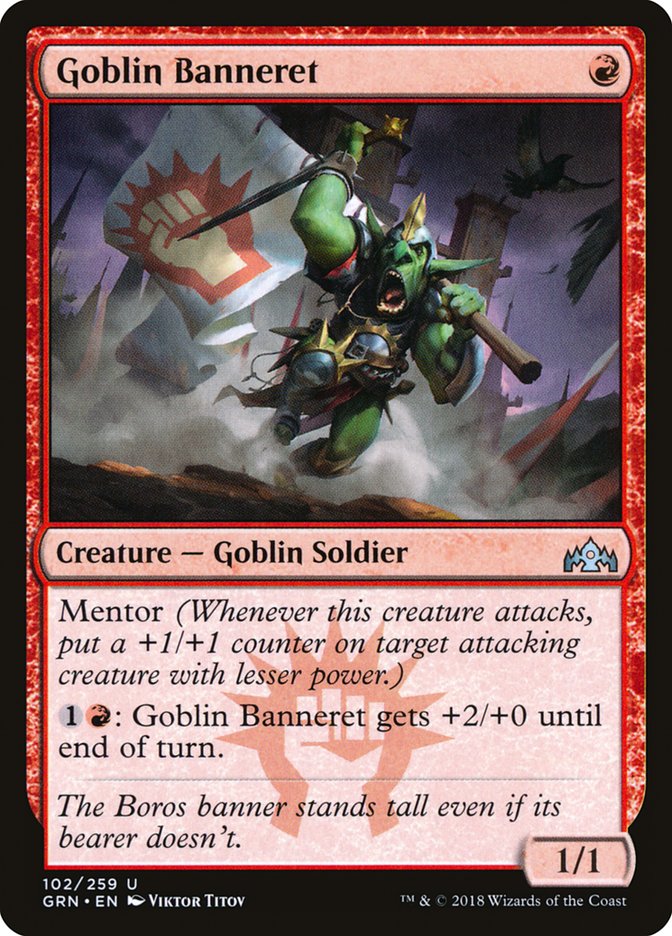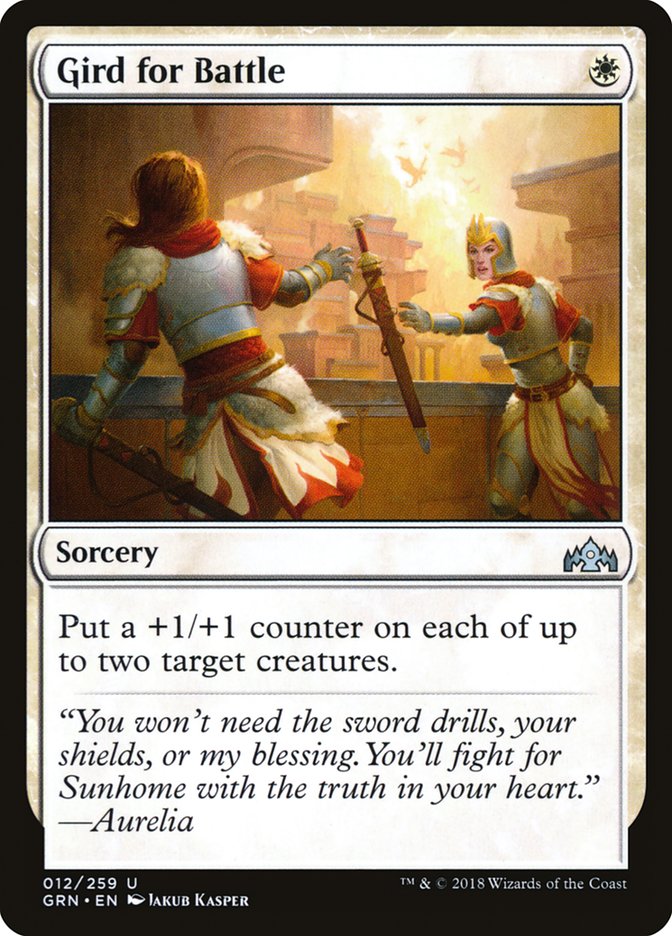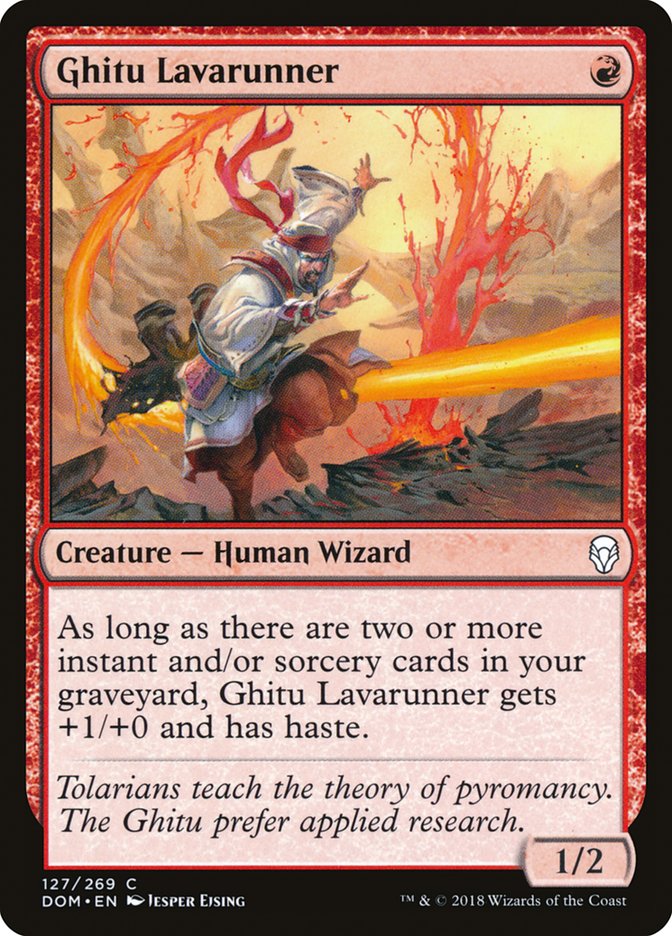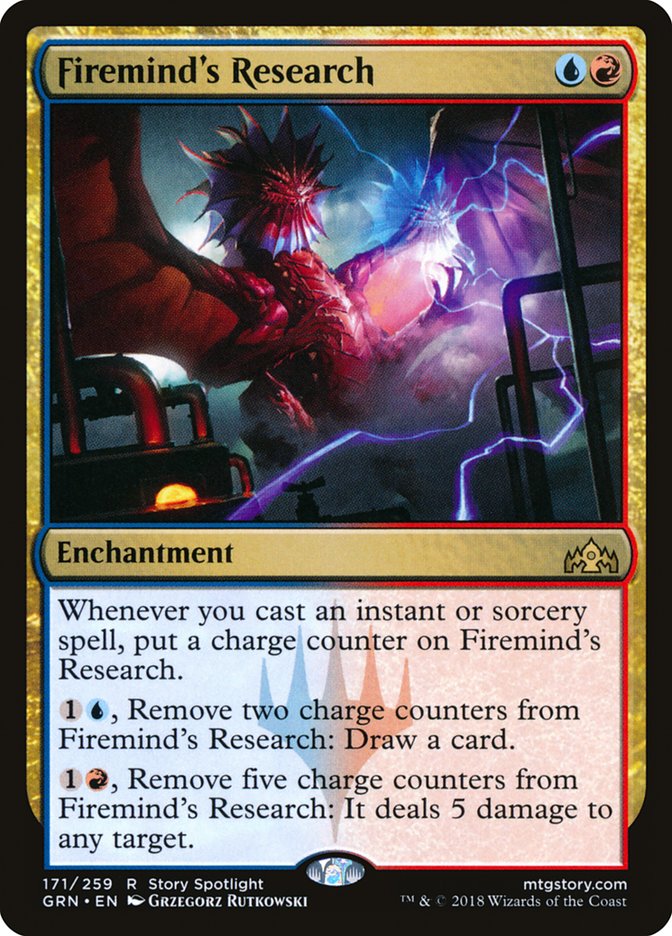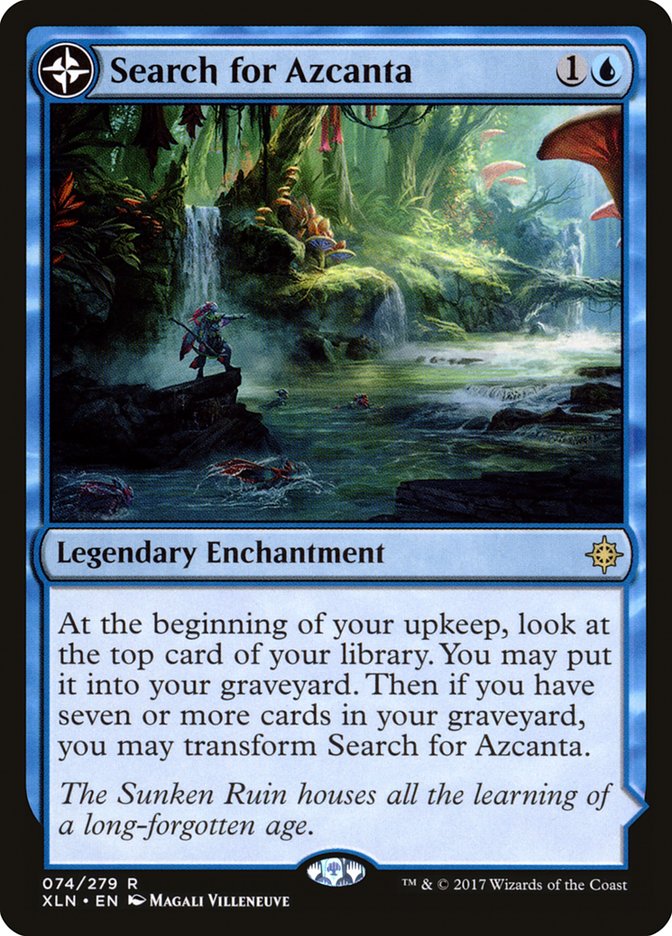I spent this weekend drafting Guilds of Ravnica with a printed
cube of test cards with friends, and was able to learn some quick, hard
early lessons.
Out of the gates, mentor really blew me away as a mechanic. Making
creatures a little bigger is a much bigger deal in Limited than it is in
Constructed, but good Boros decks snowballed fast, and I think they had the
best record of any of the guilds by far in our drafts.
My main takeaway was that mentor played better than it looks and has tons
of enablers, in the form of pumps spells and auras, on top of just playing
well naturally, and jump-start is great at giving Izzet a lot more spell
triggers than it looks like it should have.
point and then just follow along as ideas inspire other ideas.
Selesnya and Golgari felt like they were low on enablers. There aren’t
really pushed token cards to help convoke as you can just put a bunch of
creatures in your deck and use them to cast big convoke creatures. A big
problem with this is that Selesnya decks mulligan very poorly because they
just need critical mass number of cards to convoke out their payoffs.
Golgari similarly just must play undergrowth the way it looks on the
surface; there’s nothing you can combine it with to make it better than the
sum of its parts. The way you get creatures in the graveyard is just by
trading over the course of a normal game of Magic. That means Golgari must
try to block, because they need trades to happen. Their creatures don’t hit
as hard as Boros, and they have less reach than Izzet. The problem is that
blocking isn’t really a great strategy when every Izzet card forces
creatures through, and Boros has pump spells and makes their creatures
bigger by attacking. Blocking is much worse in the format than using a
removal spell if you’re trying to play a late game, which Golgari must do,
but you need to fill your deck with creatures rather than removal if you
want your mechanic to work, so it’s just in an awkward spot.
Since Limited is my first experience really getting to play with new cards,
I like to try to explore the cards that play better than I expected in
Constructed. So, for instance, it seems like people are expecting Path of
Mettle to be the driving force in Boros Aggro in Standard, but I think we
may be underestimating mentor as a mechanic, since most people don’t have
much experience seeing it in play.
My experiences make me want to try to push that mechanic.
Creatures (27)
- 4 Snubhorn Sentry
- 4 Boros Challenger
- 4 Legion Warboss
- 2 Sunhome Stalwart
- 4 Goblin Banneret
- 2 Aurelia, Exemplar of Justice
- 4 Swiftblade Vindicator
- 3 Tajic, Legion's Edge
Lands (22)
Spells (11)
Sideboard

Snubhorn Sentry plays really well with mentor because its low power allows
it to take extra counters early and often, and then if you get the city’s
blessing, it’s suddenly huge. Lifelink is also great with mentor. Healer’s
Hawk might have been the card that impressed us the most in our drafts, and
I really wanted to include it in this deck, but Legion’s Landing just seems
too much better, especially with Snubhorn Sentry, since it gives you an
extra permanent. Goblin Banneret was also extremely impressive with other
mentor creatures. The natural cap on mentor is that you can’t make anything
bigger than your largest creature, but once you get Goblin Banneret close,
you can spend mana on it before combat and then have it mentor your next
biggest creature, who can then mentor the Goblin again on the following
turn. Together, they can always keep getting bigger at a relatively low
cost.
Gird for Battle is also great with mentor, since if you play it on your
mentors it allows them to pump other creatures they otherwise wouldn’t have
been able to; it can basically give you four counters for one mana. Any
counters you can give Swiftblade Vindicator are counters that will be used
to the absolute fullest, and Integrity offers additional pump spells for
your double striking trampler that also help get over your mentoring
limits.
Legion Warboss plays really well with two-mana mentor creatures because the
Goblin it makes will get to attack as a 2/2, helping to make sure it
doesn’t just get eaten by a blocker immediately and also making sure you
don’t waste your mentor trigger.
All the mentor creatures are Soldiers, except for Aurelia, Exemplar of
Justice, so Unclaimed Territory works really well in the deck since it can
basically replace Mountains, as it can cast every red card in the deck that
costs less than four mana by naming Soldier. This makes the sideboard cards
a little harder to cast, so I wanted to keep thirteen real red sources in
the deck, but beyond that, it felt like it was probably adding some
consistency over additional basics.
As with most of my early linear builds, this minimizes removal to try to
maximize synergy, so I mostly have a variety of removal spells in my
sideboard, but I also have Experimental Frenzy, which I’d like to call out
as probably a better Vance’s Blasting Cannons.
Future Sight is an extremely powerful spell that basically makes you want
to ignore your hand anyway to keep tearing through your deck. Every now and
then, you’ll hit a land cluster and get slowed down, but this deck has a
low 22 lands and it’s almost all cheap threats, so you should be able to
cast several cards a turn after landing this. And while you’re doing that,
you’ll build up a hand you haven’t been able to use, and then you can cash
Experimental Frenzy in like a giant Bomat Courier and use all the cards
you’ve been saving. I think the card has a good chance of showing up a lot
as the red Arguel’s Blood Fast.
I mentioned that jump-start really impressed me as a way to get additional
cast triggers, and I think that’s worth exploring. There are a remarkable
number of different ways Izzet Spells can be built, but here’s one that I
think might be good:
Creatures (18)
Lands (22)
Spells (20)
Sideboard

Arclight Phoenix is a pretty horrible card to cast, and Radical Idea is a
pretty horrible card to cast from your graveyard, but when you combine
them, you can discard Arclight Phoenix to cast Radical Idea and then get a
free Arclight Phoenix when you cast your third instant or sorcery. Three is
a lot of instants or sorceries to cast in a single turn in Standard unless
you control Goblin Electromancer, and then suddenly this deck is looking at
twelve one-mana cantrips, one of which can be cast twice and another of
which draws two cards, and suddenly, Arclight Phoenix is looking very easy
to return to the battlefield.
All the cantrips are great for powering up the Wizards, but what’s really
great about this deck is how it can transform after sideboarding. Beacon
Bolt gives it easy access to a lot of removal, and Firemind’s Research and
Experimental Frenzy offer card drawing engines. This deck can transform
when the opponent tries to bring in answers to the Wizards by cutting most
of the Wizards and slowing down with trying to win with Crackling Drake.
I’m not sure about how to get the numbers exactly right to maximize that
transformation, but I think the fact that something like that can be done
is pretty awesome.
Another option is to not focus on Wizards, and instead focus on Runaway
Steam-Kin and/or Electrostatic Field:
Spells (26)
- 4 Shock
- 1 Banefire
- 4 Lightning Strike
- 4 Tormenting Voice
- 4 Crash Through
- 1 Primal Amulet
- 4 Warlord's Fury
- 4 Risk Factor
Sideboard

This deck is weirder. It’s harder for me to imagine how it plays out. It
seems like you’re pretty invested in one of your creatures living, but if
you can get Arclight Phoenix into the graveyard, you’re pretty good at
bringing it back, but I worry about drawing too many without a discard
outlet. Maybe it’s not that bad if you must cast one.
The payoff creatures die pretty easily, but on the other hand, you’re good
at drawing more of them. This deck definitely plays really well against
cards like Response, Settle the Wreckage, and Seal Away, since it doesn’t
have to attack with its creatures. It’s just really hard to me to fully
process how fast or consistent this deck is. It’s cool that it can exist
though, as it’s very different from basically any other mono-red deck I can
think of.
I’m also not sure if this should be playing Ghitu Lavarunner or not. It
would function well here, but you may just need your creatures to be higher
impact, since you want most of your cards to be instants and sorceries.
Another option is to play even fewer creatures, and go for more of a
traditional counterburn strategy:
Spells (33)
- 4 Opt
- 1 Syncopate
- 2 Essence Scatter
- 2 Lightning Strike
- 2 Search for Azcanta
- 1 Sinister Sabotage
- 3 Radical Idea
- 4 Firemind's Research
- 4 Ionize
- 2 Chemister's Insight
- 1 Expansion
- 2 Lava Coil
- 3 Beacon Bolt
- 2 Devious Cover-Up
Sideboard

Arclight Phoenix plays as something like a Nether Spirit to Firemind’s
Research’s Dynavolt Tower in this Izzet control deck. Arclight Phoenix has
a bit of a weird play pattern here, in that you’ll never want to cast it
and you’re also not really planning to cast three spells in one turn most
of the time, so it won’t return to the battlefield frequently, but when it
does, it will make it a lot easier to turn the corner.
All the grindy sideboard-type enchantment cards like Firemind’s Research
and Search for Azcanta are in the maindeck, so instead, this deck turns to
creatures to shift gears after sideboarding, with powerful fliers that
generate card advantage. Getting the mix of interaction, cantrips, and card
advantage just right is tricky, but Firemind’s Research and Search for
Azcanta play extremely well together and with other cheap cantrips and
jump-start cards, so I think there’s something here.
I also think Firemind’s Research plays well with Arclight Phoenix in this
deck–early in the game, you’ll be using cantrips and interactive spells to
get counters on Firemind’s Research, then you reach a point where you have
some counters, but your mana’s taxed by interacting with your opponent.
Once you have mana free because your opponent runs out of steam, or can
only cast one threat and you can answer it cheaply, you can spend mana
drawing cards with Firemind’s Research which is mana you’re not spending on
a cantrip. This mana, in turn, helps you build a hand so that you can “go
off” by casting three spells once the game has gone on for a while, and
ideally, you can get two copies of Arclight Phoenix back.
I haven’t drafted anything like this deck, so this has taken a bit of a
departure from exploring themes that performed well in Limited, but that’s
an important part of the creative process: find inspiration in something
and then just follow where it takes you. This reminds me of a discussion I
just listened to on
this podcast
that interviewed my mom. My mom’s an artist, and while my grandmother was
dying of Alzheimer’s, my mom would draw her to stay connected while
watching over her when she spent most of her time asleep. After she died,
my mom had trouble making art for a while until she followed a prompt to
just start drawing spirals every day to get her hand moving and then just
see what became of the drawing, allowing herself to branch out after a few
minutes of drawing spirals.
My writing and deckbuilding function like that: find some kind of starting
point and then just follow along as ideas inspire other ideas. For example,
after making that Izzet control deck and saying I haven’t drafted anything
like that, I’m inspired to see if it’s possible to draft anything like
that. I don’t know if there’s enough removal, but some key elements are
there. I’ve only drafted Izzet as an aggro deck that uses jump-start cards
to push early creatures through, but now I want to look to draft a pure
control deck with Devious Cover-Up and maybe Grixis for more removal.


